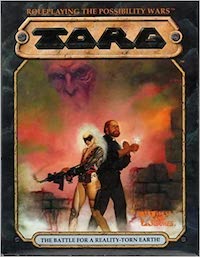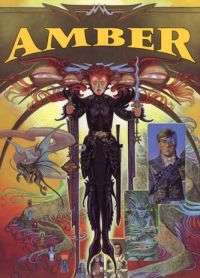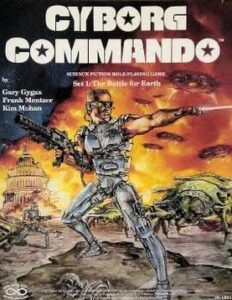RIFTS is a roleplaying game designed by Kevin Siembieda and originally published by his company Palladium Books in 1990. In this episode we examine the Rifts Ultimate Edition from 2005, a revised and expanded version of the original game rulebook. Like it, hate it or previously unaware of it, there’s nothing like it on the market today and we enjoyed the chance to delve into what makes it work.
- See the original Rifts rulebook at DriveThruRPG
- See the Rifts Ultimate Edition at DriveThruRPG. We can’t speak for other Rifts PDFs but this PDF is a scan of the print book, every page is an image, the text is not searchable, there is no indexing or bookmarking. It’s like an artefact from a more primitive time.
- See the Rifts game-line at the Palladium Books website
- See Savage Rifts at DriveThruRPG
“‘Rifts is a thinking man’s game’ – that’s a quote from the book…” – Ross
This episode is brought to you with thanks to our Kickstarter backer Scribblykins, who comments, “RPPR consists of a buncha great guys and gals playing (and occasionally making) roleplaying games and having a fun time of it. There’s a main podcast that goes into various role-playing related experiences, happenings, news, game design discussions, whatever catches podcast creator Ross Payton and his associates’ fancy, but the real meat is in the wealth of Actual Plays. Have fond memories of episodes such as Shipping: The Devil and Actual Play classics like U-Boote Heraus, Lover in The Ice and They Served Brandolyn Red. They’ve run some really great stories over their years and it’s all accessible and FREE! And if you sponsor them on Patreon with at least 10$, you can participate in online games or even get design feedback on your games from Ross Payton as well! What’s not to like?!”
SHOW NOTES
These are the notes for the episode, a chance for us to pick up the threads, fill in the blanks and correct the occasional errors that we didn’t have time to pursue in the episode itself.
Palladium Books was formed in 1981 and its first RPG, The Mechanoid Invasion, came out the same year. Kevin Siembieda set up the company to release the Palladium Role-Playing Game (now known as Palladium Fantasy RPG) which he had developed from his house-rules for a long-running AD&D campaign, but initially lacked the money to do it as the big book he wanted to publish. The Palladium RPG finally came out in 1983, arguably the first RPG rulebook sold as a large-format perfect-bound softback book (if you overlook things like Games Workshop’s softcover reprints of the AD&D Player’s Handbook and Monster Manual, only released in the UK).
The Palladium RPG system, the foundation for almost all the company’s RPGs* has its roots in AD&D‘s class-and-level system but adds to it: most notably a skill system and bigger numbers. These days the house rules are mostly based on the mechanics seen in Rifts and are known as the ‘Megaversal System’. Games commentators agree they are needlessly complicated by modern standards, and even by the standards of when they were published.
* Valley of the Pharoahs (1983) uses a different system, and came in a cardboard box, and was not very good.
Working for Palladium: game designer Bill Coffin was at the company for five years, 1998–2002, and is listed as author or co-author on books for Palladium Fantasy, Rifts, Heroes Unlimited and his own post-Y2K apocalypse game for the company, Systems Failure. He was fired for what Wikipedia calls ‘editorial differences’. Coffin described thse differences at length, and talked about his experiences working at Palladium, in an RPG.net post from 2012. Hint: he is not complimentary.
Legals: Kevin Siembieda is (or was) notorious in the industry for his litigious zeal in defending Palladium’s IP. For a long time the industry norm was to let magazines and websites commit minor trademark infractions by publishing material for well-known RPGs: the publishers could have sued but usually let it go as good publicity instead. Siembieda went the other way. An example: in 1992 a pre-Magic Wizards of the Coast published The Primal Order, a fantasy-gods sourcebook that contained rules for converting its material to other fantasy RPGs, including the Palladium RPG. Palladium sued for infringement of copyright, and it took an intercession by Mike ‘Cyberpunk‘ Pondsmith, then head of GAMA, to persude them to reach a settlement.
Covers: top-level Palladium artists of yore include Eastman and Laird of Teenage Mutant Ninja Turtles fame, Kevin Long, Keith Parkinson, and John Zeleznik. Zeleznik still arts for the company.
We talked about creativity arising from constraint. There is nothing worse for a creative brain than a blank sheet of paper. Put three dots on it and suddenly the mind has something to start coalescing ideas around. Any competent GM should be able to improvise an adventure from five words chosen at random from a dictionary.
Palladium and embezzlement: in 2006 Kevin Siembieda revealed that a member of staff (later revealed to be sales manager Steve Sheiring) had stolen between $850,000 and $1.3m from the company over two years, leaving it in a severe financial hole. Fundraising from fans was able to keep it afloat.
The fact that Palladium’s books are cheaper than the industry average, and particularly cheaper than the AD&D titles that Palladium RPG was competing against in the 1980s, along with the bold and colourful cover art of most of its games, gave it an appeal to younger players buying their first RPGs. Despite the ‘churn’ in players and purchasers that all RPG companies face, this could be one of the reasons for Palladium having an audience that is distinct and somewhat separate from the rest of the RPG hobby. There is strong brand loyalty among Palladium fans, some of whom see Siembieda as a Stan Lee-like creator in chief, something the company does little to deny.
In the pre-desktop publishing days of the 1950s-1980s, photo-typesetting machines were the way that camera-ready columns of text were created. An operator entered the text and it was output onto photographic paper, which the layout artist would then paste onto the layout board, to create a page which the printer would photograph at 1:1 and use to create the printing plates. Even in the 1980s most had very limited storage and a very small number of fonts, which may explain why Palladium’s books were and are all set in Times New Roman.
Mega-damage, which was introduced in the Robotech RPG before appearing in Rifts, is regular damage x100. It has its own system of hit-points: MDC, or ‘Mega Damage Capacity’. It is the sort of over-the-top game mechanic that 14-year-olds absolutely love.
In the podcast Greg likened Rifts to a ‘buffet’ – this is a good analogy, but we’re talking about Rifts so it’s more like ‘buffet the vampire slayer’.
‘Glitterboy’ is a term for powerful suits of mech-like body armour that stand ten feet tall and predate the great cataclysm, and also for the pilots of those suits, one of the Rifts OCCs (Occupational Character Classes). There are at least fifteen different types of Glitterboy armour but they almost all carry a very large railgun (‘Boom Gun’) capable of inflicting megadamage. There’d be a picture here, but see eight paragraphs up.
Cyborg Commando was the first RPG that Gary ‘D&D‘ Gygax published after he was forced out of TSR, designed by him with Frank Mentzer and Kim Mohan, and released by his company New Infinities in 1987. It focuses on mechanical soldiers implanted with human brains, built to fight an alien invasion. The game failed on all levels: it was a dystopian setting before they were popular, it had narrow focus, complicated but uninteresting mechanics, and the cover-art was poor by the standards of the time. Be grateful it is not available as a PDF, you’re missing very little.
 Torg was another fractured-reality RPG, mixing multiple genres in a single rules-set, released as a boxed set the same year as Rifts. It was designed by Greg Gorden and Bill Slavicsek, and published by West End Games, the company’s first major RPG since Star Wars in 1987. With mechanics powered by a single d20, cards to generate game and narrative effects in combat, and a consciously cinematic feel, it stood in hard contrast to Rifts, and though it did well for a while, it did not sustain. There’s a pay-what-you-want Torg introductory pack downloadable from DriveThruRPG.
Torg was another fractured-reality RPG, mixing multiple genres in a single rules-set, released as a boxed set the same year as Rifts. It was designed by Greg Gorden and Bill Slavicsek, and published by West End Games, the company’s first major RPG since Star Wars in 1987. With mechanics powered by a single d20, cards to generate game and narrative effects in combat, and a consciously cinematic feel, it stood in hard contrast to Rifts, and though it did well for a while, it did not sustain. There’s a pay-what-you-want Torg introductory pack downloadable from DriveThruRPG.
“The remaining 80% of everything that will turn up in search is just AI swill’ (Greg) – that figure of 80% is charitable, we refer the reader to Sturgeon’s Law, named for SF author Theodore Sturgeon and first stated in 1951: “90% of everything is crap”.
Caleb Stokes, referred to a couple of times in the podcast, is the creator of the Red Markets RPG (analysed by us in season 2 episode 3) and regularly appears on Ross’s other podcast Roleplaying Public Radio (RPPR).
Savage Worlds Rifts is, as you’d expect, a combination of the Rifts background with the Savage Worlds RPG mechanics. We previously reviewed Savage Worlds in season 3 episode 3, and liked it a lot. Ross has run a Savage Worlds Rifts campaign which you can listen to as an actual-play here.
Dark Star (1972), John Carpenter’s first movie, is a fantastically bleak and funny piece of low-budget SF (it cost $60,000 to make), from that weird period mid-way between 2001: A Space Odyssey and Star Wars. It is extremely quotable (it was co-written by Dan ‘Alien‘ O’Bannon, who also co-stars, edited it, and was production designer and VFX supervisor, on a team that included the great Ron Cobb.) It can be summed up in one piece of dialogue: “Think we’ll ever find any real intelligent life out there?” “Who cares.”
Rifts: Promise of Power, the Rifts video game, was developed by Backbone Entertainment and released in 2005 for the Nokia N-Gage, to positive reviews. You can watch a playthrough of the whole thing here. Palladium will shortly launch a crowdfunding campaign to bring it back as a PC conversion.
 The Nokia N-Gage was Nokia’s attempt to enter the handheld games console market in 2003 despite being ugly, underpowered, awkward to use, and a battery-eater. The arrival of the Sony PSP and the Nintendo DS a year later cemented its casket. Sales were abysmal, the mockery enduring.
The Nokia N-Gage was Nokia’s attempt to enter the handheld games console market in 2003 despite being ugly, underpowered, awkward to use, and a battery-eater. The arrival of the Sony PSP and the Nintendo DS a year later cemented its casket. Sales were abysmal, the mockery enduring.
Rifts was optioned for a movie by Jerry Bruckheimer Films and Walt Disney Pictures in 2003, The option was still being renewed in 2011 but news has been scant since then and it has almost certainly lapsed. You can actually buy a copy of a movie screenplay, Rifts: Path of the Storm by Matthew Clements and an official Rifts sourcebook based on it from Palladium. This was not a screenplay commissioned by the film company, someone just gave it to Siembieda and he liked it enough to release it himself.
The Rifts alignment system is, as mentioned in the podcast, based on Good, Selfish, and Evil, but there are subdivisions. Good includes Principled and Scrupulous, Selfish includes Unprincipled and Anarchist, and Evil includes Aberrant, Miscreant and Diabolic. There are no neutral alignment in Rifts. The Mystic China game/supplement introduced Taoist but it didn’t stick. Make of that what you will.
 Amber Diceless Roleplay was the first commercial diceless RPG, based on the Chronicles of Amber novels by Roger Zelazny and released in 1991 by Erick Wujcik, Palladium designer and longtime friend of Siembieda, under his own Phage Press imprint. It caused a stir at the time, was a critical success and still has followers today. Wujcik released one supplement for it, Shadow Knight (1993). We will doubtless cover the game at some point on LND, but not yet.
Amber Diceless Roleplay was the first commercial diceless RPG, based on the Chronicles of Amber novels by Roger Zelazny and released in 1991 by Erick Wujcik, Palladium designer and longtime friend of Siembieda, under his own Phage Press imprint. It caused a stir at the time, was a critical success and still has followers today. Wujcik released one supplement for it, Shadow Knight (1993). We will doubtless cover the game at some point on LND, but not yet.
If the idea tickles you, Lords of Gossamer and Shadow uses the same system to tread very similar ground, and is better supported.
In the episode James mentioned how Erick Wujcik screwed up his career in the 1990s, first by accident and then on purpose, and he doesn’t particularly enjoy revisiting those times, but here’s a link to a piece he wrote about it fifteen years ago. If you’d like to know more or have questions, the place for them is the Ludonarrative Dissidents Discord channel.
Thank you for listening! The hosts of this episode were Ross Payton, Greg Stolze and James Wallis, with audio editing by Ross and show notes by James. We hope you enjoyed it. If anything in this episode or these notes has spurred your interest then we invite you to come and chat about it on our friendly Discord.
If you click on any of the above links to DriveThruRPG and buy something, Ludonarrative Dissidents will receive a small affiliate fee. You will not be charged more, and the game’s publisher will not receive less, it’s a win-win-win. Thank you for supporting the podcast this way.

